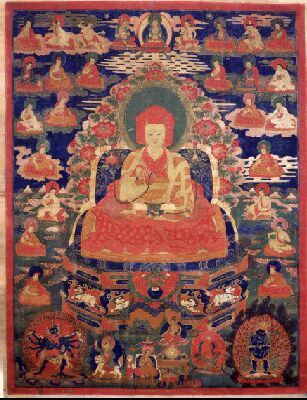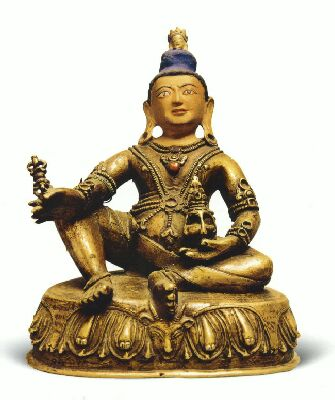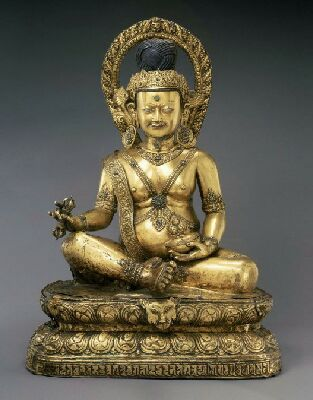Biography and autobiography in Tibet are important sources for both education and inspiration. The authors involved in the Treasury of Lives mine primary sources to provide English-language biographies of every known religious teacher from Tibet and the Himalaya, all of which are organized on their website. The following summarizes the biography of the Fourth Dalai Lama, Yonten Gyatso, by Miranda Adams.

What appears insane is an expression of enlightenment. This archetype of the holy madman holds considerable weight in social and cultural discourses in Tibet and the Himalayas. In fact, many lineages of Tibetan Buddhism trace their origins to mahasiddhas (“great adepts”) that were known for eccentric demonstrations of their awakening in addition to their spiritual accomplishments. Scantily clad and sometimes intoxicated, having left their monasteries to wander through forests (just some of the tropes we find in these tales), these holy madmen were celebrated for their ability to see through and beyond cultural conventions and free themselves from the constraints of natural law. The term “madman” however, is not entirely accurate. Enacted by highly self-aware individuals, quirky behaviors make strategic use of madness in the construction of public personas, allowing some adepts to build and maintain considerable power in the social and religious structures of Tibet.
Born in 1452 in a village called Kharkha in western Tibet, the country’s most famous holy madman, Tsangnyon Heruka (1452–1507), is a cherished example of the archetype. Overwhelmed with feelings of disgust toward cyclic existence and with compassion for the beings that suffer therein, Tsangnyon became a novice monk. He quickly became famous for his great emphasis on discipline and, studying many sutras, he was also recognized for his capacity to recite texts by heart. During this period it is said that he had several dreams and visions urging him to leave his home, and when he was around 18, he finally managed to do so.

Soon after, he met Shara Rabjampa Sanggye Sengge (1427–1470), popularly known as Sharawa, who would become his primary teacher. After spending nine months with Sharawa and having completed his studies and meditation training, Tsangyon, at the behest of his teacher, left behind all worldly concerns to venture to the holy places of Tibet—Tsari, Tsagong, Labchi, Chuwar, and Mt. Kailash. Tsangnyon first practiced meditation at Tsari and then studied the tantras in the famous Pelkhor Chode Monastery in Gyantse. After about three years of study he became expert in many tantras, their Indian and Tibetan commentaries, and the performance of complicated tantric rituals.
Tsangnyon’s actual debut as a mad yogin occurred when several distinguished guests happened to be visiting his monastery. On this occasion, he behaved in such an insulting and crazy manner that the master of studies of the monastery had to rebuke him. After this incident, the 21-year-old monk left his monastery and became a wandering yogin with no fixed abode, behaving and dressing in a manner that set him apart from most Buddhist masters of Tibet. Instead of becoming a fully ordained monk, which would have been the natural way to proceed, he began to model his lifestyle and practice on the siddhas of India, keeping long hair, dressing in the full heruka garments (scantily clad, wearing bone ornaments and a top knot), carrying a tantric staff and a skull-cup. This radical move away from the monastery upset some of his contemporaries while inspiring devotion in others.

A few years after Tsangnyon left his monastery, it is said that he, after having pondered how to benefit the Buddhist doctrine and living beings, entered a gathering behaving very provocatively and strangely. Instead of clothes he wore pieces of human corpses that he found on a charnel ground, and he alternated between laughing and crying. Witnesses started to call him “the Madman of Tsang: (Tsangnyon), the sobriquet under which he would henceforth be known.
Biographies of Tsangnyon include episodes in which monk-scholars question his behavior and manner of dress, saying that his way of practicing did not correspond with the Buddhist teachings. Tsangnyon then surprises his antagonists by giving precise and accurate explanations, often quoting appropriate texts at length. He claims that his unconventional and at times seemingly crazy way of practicing Buddhism are in fact rooted in and justified by authoritative Buddhist scripture, specifically the higher yoga tantras.
Tsangnyon became famous for his songs, poetry, and important literary works—most notably, The Life and Songs of Milarepa, one of the most widely read pieces of Tibetan literature. A pioneer in using relatively new woodblock-printing technology, Tsangnyon was able to make many copies of his works and distribute them widely. In this way, in addition to being one of Tibet’s greatest authors, Tsangnyon was a key figure in the history of printing in the country.
As his fame steadily increased, Tsangnyon became an important political figure in Tibet and elsewhere. It is paradoxical, perhaps, that a man who lived the life of a mendicant yogin and emulated and propagated the lifestyle of Milarepa had so many important connections to powerful Tibetan leaders. According to his biographies, Tsangnyon sometimes used his influence to reconcile opposing factions in political conflicts, including wars. It was not uncommon for parties on both sides of a dispute to share Tsangnyon as a teacher, and thus respect his wishes.
In 1507, Tsangnyon began showing signs of illness and decided to journey to Rechung Puk, south of Tsetang, to expire. A few weeks later, at age 55 (or 56, according to Tibetan reckoning), he passed away.
Thank you for subscribing to Tricycle! As a nonprofit, we depend on readers like you to keep Buddhist teachings and practices widely available.